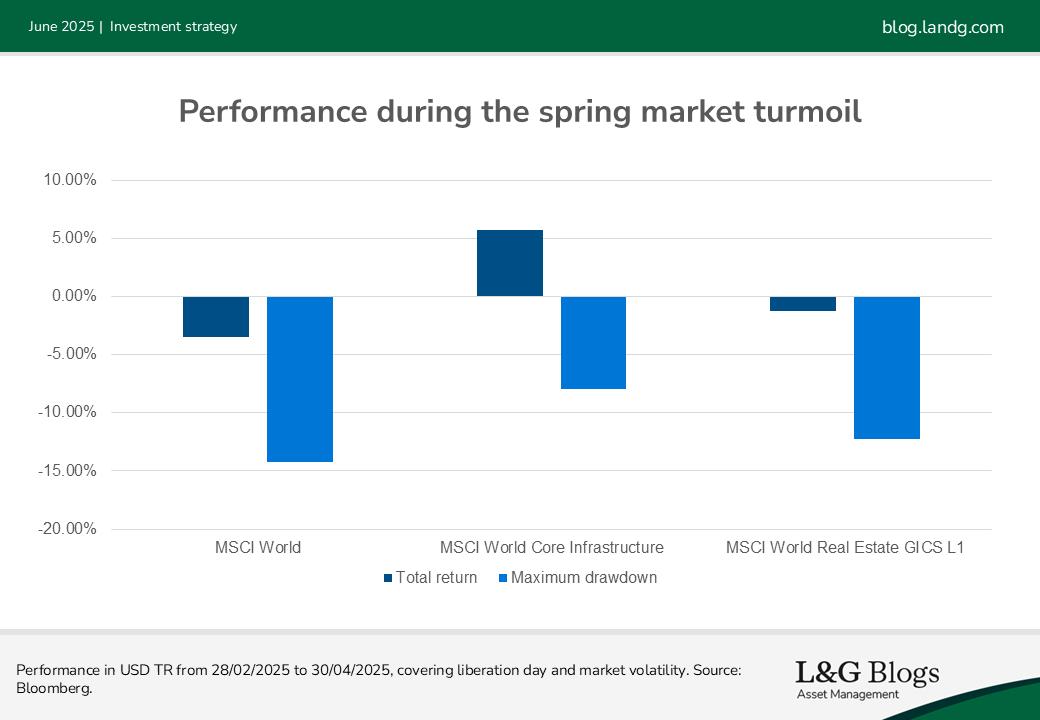Disclaimer: Views in this blog do not promote, and are not directly connected to any L&G product or service. Views are from a range of L&G investment professionals, may be specific to an author’s particular investment region or desk, and do not necessarily reflect the views of L&G. For investment professionals only.
The role of real estate and infrastructure in portfolio diversification
In the second instalment of our series on overcoming equity market concentration risk, we examine how real estate and infrastructure assets can contribute to a resilient portfolio.

If the start of 2025 taught us anything, it's that putting all your eggs in one basket – especially a basket filled with mega-cap tech stocks – can leave portfolios vulnerable when the winds shift. And shift they did: sticky inflation, rising tariffs and geopolitics disrupted global markets. At the same time, returns became more concentrated, and the drawdowns, when they came, hit hard and fast.
In times like these, investors often rediscover the power of diversification*. In part one of this series, we showed how regional diversification has historically helped mitigate drawdowns.
But diversification needn’t just mean exposure to a variety of regions. Accessing different types of assets, such as infrastructure and real estate, can also increase diversification. These assets have proven themselves as portfolio workhorses: not always flashy, but often steady and income-generating. And, when it comes to core infrastructure, they are particularly resilient.
Here’s the twist: their value isn’t only revealed during storms. These sectors provide structural, long-term roles in portfolios. Let’s explore why.
The real deal with real assets
Infrastructure and real estate aren’t just about roads, pipes and buildings. They're about access to physical, income-producing assets that tend to behave differently from traditional equities. That difference matters.
While stock markets were volatile earlier this year with global equities under pressure and leadership from mega-cap names faltering, real assets told a calmer story. Yes, real estate had its own cyclical quirks. But both infrastructure and real estate showed lower correlation to broader markets, and in many cases, offered smoother returns during the roughest patches.

Correlation matrix: equities, infrastructure, real estate and fixed income

Guide: 0-0.2 (low), 0.21-0.4 (med-low), 0.41-0.6 (med), 0.61-0.8 (med-high), 0.81-1 (high). Correlation is sourced from Bloomberg based on weekly analysis from 30/04/2015 to 30/04/2025 in USD for MSCI World- MXWO index, MSCI World Core Infra- M2CXRA Index, MSCI World Real Estate- MXWO0R Index, and Bloomberg Global Agg Index- LEGATR Index.
Infrastructure: a foundation that’s also plugged into the future
Regulated utilities, energy networks, water systems and toll roads aren’t exciting dinner-party topics, but they are services people rely on in all economic environments.
That’s part of what makes infrastructure sit at the more defensive end of the asset class spectrum. Revenues tend to be contracted or regulated, demand is inelastic and returns often move independently of broader equity markets. Crucially, many of these cash flows are also inflation-linked, making them particularly valuable when prices stay elevated.
But here’s where it gets interesting: the sector is also tapping into the next wave of global growth. Artificial intelligence, electrification and digital infrastructure are all hungry for power. Data centres need electricity and cooling. Chips need factories. Supply chains need modern ports and railways.
Infrastructure is no longer just the concrete beneath our feet; it's the connective tissue of tomorrow’s economy.
Real estate: thematic, tangible and tied to growth
Real estate brings a different flavour. It tends to be more cyclical, yes. But it also captures economic evolution in real time. Some sectors, such as traditional retail or offices, have faced disruption as online shopping and hybrid working have become mainstream. But others are thriving. Logistics hubs and residential housing, for instance, are responding to how we live in a post-pandemic, AI-driven, urbanising world.
Real estate also offers income potential, often through long-term leases that, in many cases, include inflation-linked escalators. It's this combination of income, exposure to real assets, and thematic growth that helps explain why real estate has become a core allocation for many long-term investors.
The takeaway
You don’t need a market crisis to see the case for infrastructure and real estate. But the volatility of recent months has perhaps made it clearer.
Infrastructure, in our view, offers stability with a structural growth twist. Real estate provides tangible access to economic evolution. Together, they have the potential to bring income, diversification and long-term relevance not just as a tactical hedge, but as strategic pillars in a resilient portfolio.
Because when markets get rough – and they routinely do – it’s often the most grounded assets that help you keep your balance.
In the next part of this series, we’ll examine how US policy risk could shape the outlook for real estate and infrastructure assets – and what investors might do about it.
*It should be noted that diversification is no guarantee against a loss in a declining market.
Recommended content for you
Learn more about our business
We are one of the world's largest asset managers, with capabilities across asset classes to meet our clients' objectives and a longstanding commitment to responsible investing.

